| Title | ROBOTICS;NOTES ELITE |
| Released | June 26, 2014 (JP) October 13, 2020 (WW) |
| Developer(s): | MAGES. Inc. |
| Publisher(s): | Spike Chunsoft Co., Ltd. |
| Platform(s): | |
| Genre | Visual Novel, Adventure |
| Rating | T |
Completed on PC with CoZ Patch
HowLongToBeat Time: 46 Hours (Completionist) | My Clear Time: 55h 24m
Background
Robotics;Notes Elite is a remastered version of the original Robotics;Notes, the third part of the Science Adventure series developed by MAGES (formerly 5bp). The game first released in 2012 for PlayStation 3 and Xbox 360 and was later enhanced with updated visuals and other improvements for newer platforms in 2018 (Japan) and 2020 (worldwide). It is set in a near-future world where high school students explore the realms of robotics and technology, touching on larger themes of conspiracy, ambition, and personal growth.
In addition to its remaster, Robotics;Notes Elite also saw a fan-driven push for localization through Operation HiddenHand, a campaign dedicated to bringing the Science Adventure series to Western audiences. The campaign gained significant traction, showing the power of passionate fan efforts.
The campaign’s success was acknowledged by ROBOTICS;NOTES producer Tatsuya Matsubara, who noted that the voices of fans helped sway the decision to localize the game. Matsubara shared in a community Q&A with Spike Chunsoft (via KiriKiriBasara), “We saw the petition and heard the voice of the fans, and these things can really sway if we do or don’t localize a title. The results were…well, you know what happened, right?”
Unlike its predecessors, Steins;Gate and Chaos;Head, Robotics;Notes has a slightly different tone, blending lighthearted moments with deep, dramatic storytelling. In an interview with Siliconera, Localization Producer Toshihiro Beppu and Localization Editor Matthew Edwards discussed the tonal shifts in the Science Adventure series, noting that Robotics;Notes balances a more “slice-of-life” style with moments of intensity. Edwards highlights how the tone aligns more with the experiences of high school and early college-aged characters, making it feel more relatable.
“The tonal shifts are very interesting, especially in DaSH. Some story routes are fantastical, while others can be rather dramatic and intense. When I compare Robotics;Notes to Steins;Gate and Chaos;Head, Chaos;Head feels to me like the darkest of the three, and Steins;Gate can be fairly intense as well.
Siliconera
But given the ages of the main characters at the start of these games, what I like about Robotics;Notes is that its lighthearted and slice-of-life style seems, to me, to be the most accurate to what high schoolers and early college age kids feel and go through.”
— Matthew Edwards, Localization Editor
The development team for ROBOTICS;NOTES ELITE includes:
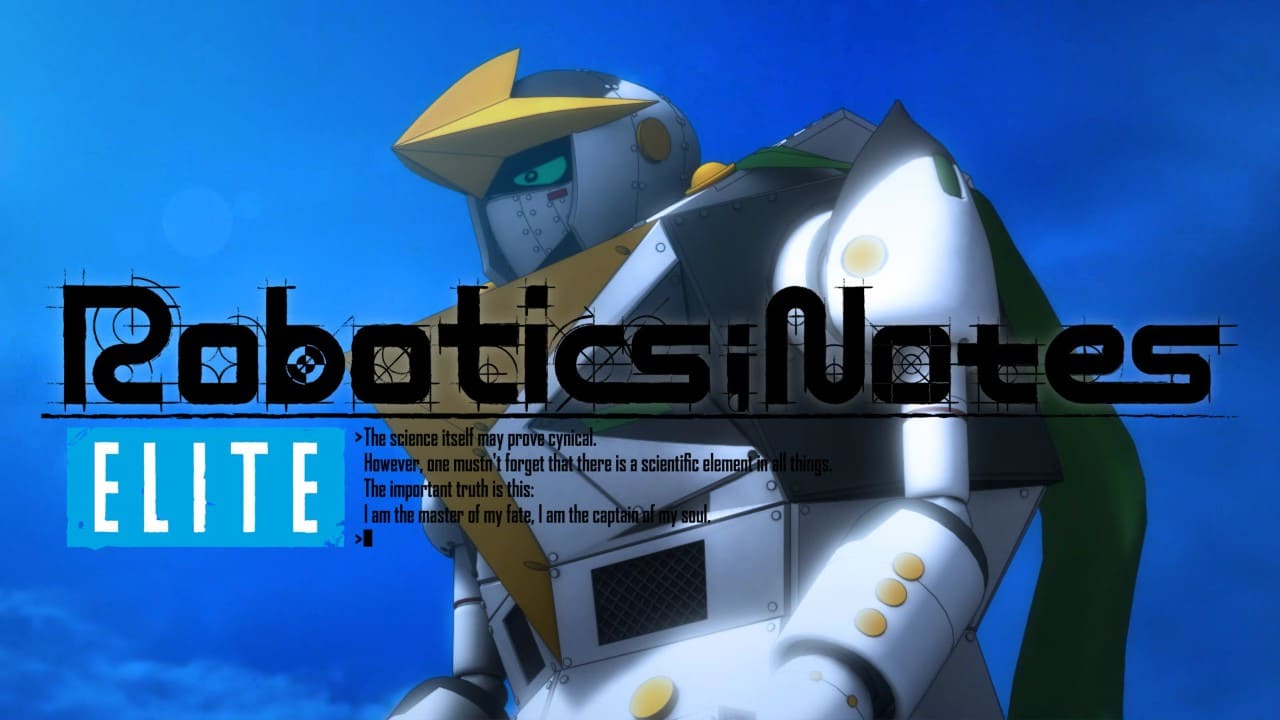
The game opens with a reflection on science, destiny, and the human element behind technology.
- Naotaka Hayashi, Chiyomaru Shikura (Scenario, Planning)
- Naotaka is known for Anonymous;Code, Chaos;Head Noah, Steins;Gate, Robotics;Notes, Steins;Gate 0.
- Chiyomaru is known for Chaos;Head, Chaos;Child, Steins;Gate.
- Toshihiko Kajioka (Director)
- Known for Breakdown, Dunamis 15, Steins;Gate 0, Chaos;Child
- Tomonori Fukuda, Ryo Ueno (Character Designer / Artist, Art Director)
- Tomonori is known for Famicom Detective Club: The Girl Who Stands Behind, The Missing Heir, Emio – The Smiling Man: Famicom Detective Club
- Ryo is known for Famicom Detective Club: The Girl Who Stands Behind, The Missing Heir, Anonymous;Code
- Takeshi Abo (Composer)
- Known for Famicom Detective Club: The Girl Who Stands Behind, The Missing Heir (2021, arranged scores), Steins;Gate, Chaos;Head Noah.
- Tatsuya Matsubara (Producer)
- Tatsuya is known for Chaos;Head Noah, Anonymous;Code, Steins;Gate
Experience
Before starting Robotics;Notes Elite, I was already familiar with the Science Adventure series. I had watched the Steins;Gate anime shortly after it aired, and later explored Steins;Gate 0, along with the OVAs and movies. I also recently finished the visual novels for Steins;Gate and Chaos;Head Noah in sequence.
What intrigued me most about Robotics;Notes Elite was the shift in presentation from the 2D visuals I was used to in Chaos;Head Noah and Steins;Gate to the more dynamic Live2D approach. While I was familiar with MAGES’ use of Live2D in their remakes of Famicom Detective Club, I hadn’t seen this style applied to Science Adventure titles before.
I was also curious about how the tone of Robotics;Notes would compare to Chaos;Head’s feverish intensity and Steins;Gate’s emotionally charged melodrama. I expected Robotics;Notes to offer a different emotional experience, with its balance of lighter, slice-of-life moments and heavier themes.
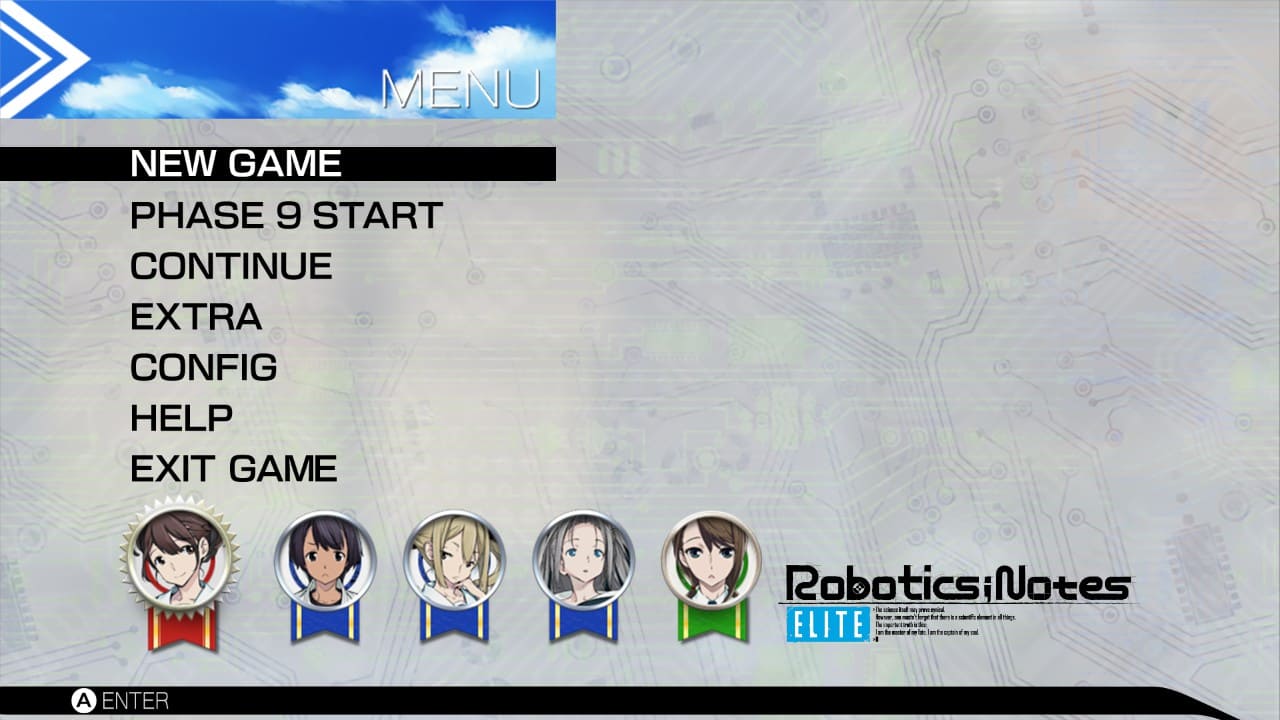
The main menu shows all routes completed—proof of a true Science Adventure veteran.
Impressions
Introduction
Robotics;Notes Elite opens with a sleek, minimalistic menu that hints at a calm before the storm—a visual promise of the more measured narrative to come. Unlike the immediate burst of eccentric energy found in earlier entries, the game eases you into its near-future world where everyday life and groundbreaking robotics intersect.
As you begin your journey, you’re introduced to a setting where high school students navigate the subtle tensions of technological progress, hidden conspiracies, and personal ambition. This quiet invitation perfectly sets the stage for a story that weaves slice-of-life moments with underlying suspense, capturing the essence of the third entry in the Science Adventure universe without giving too much away.
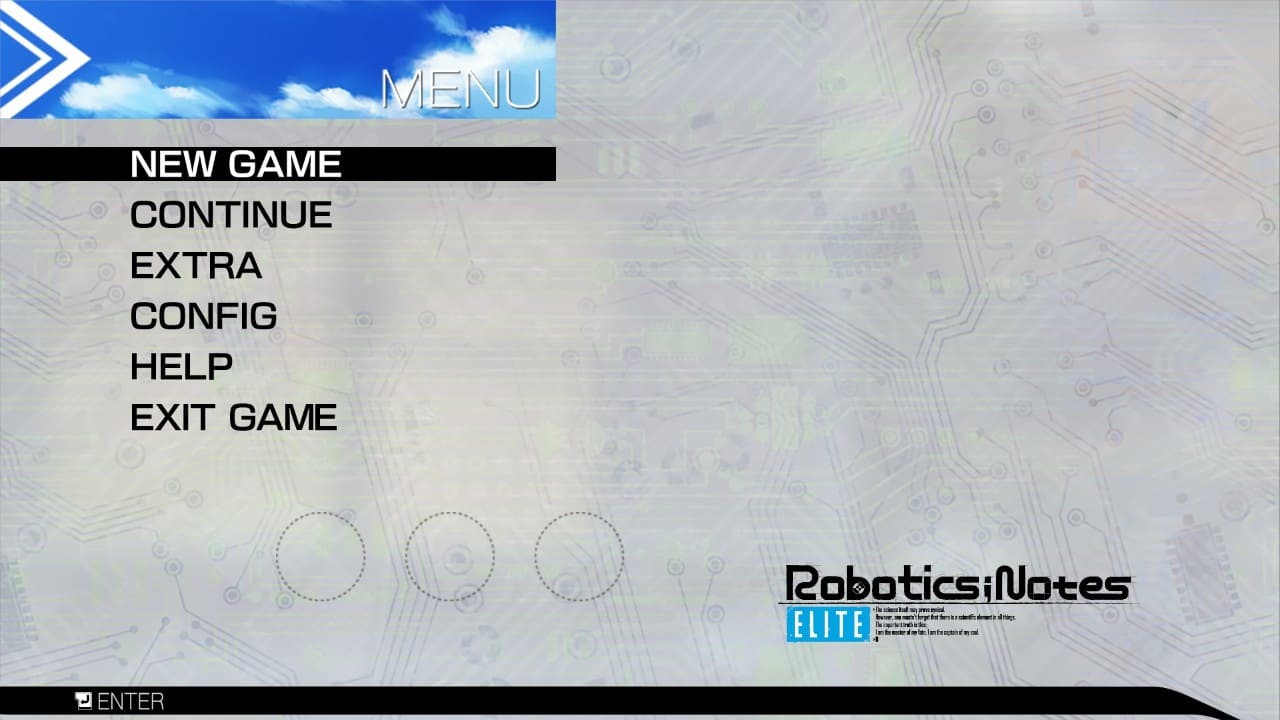
The minimal menu invites you into the chaos of science and adolescence.
Gameplay and Mechanics
Robotics;Notes Elite revives the messaging mechanic from Steins;Gate—allowing you to reply to messages on specific days to alter your route. All the familiar features from Chaos;Head Noah onward—skip, backlog, save/load, locking save files, tips—are here.
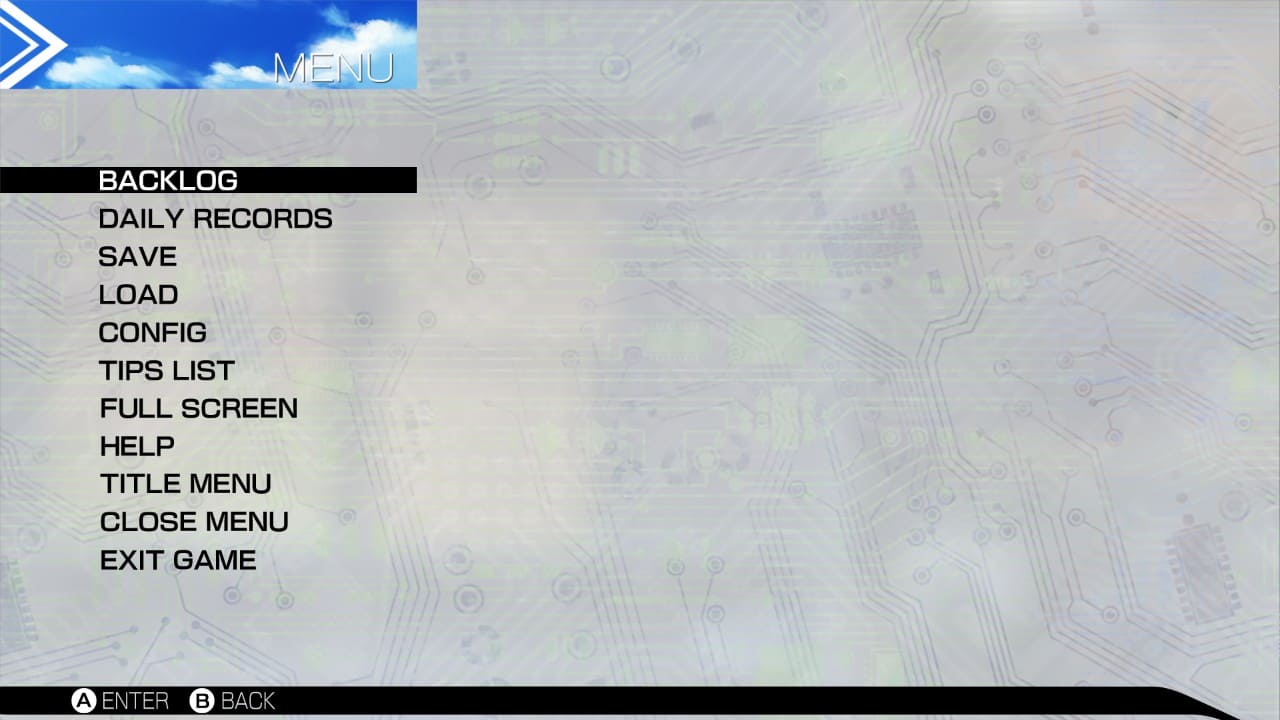
From saving progress to checking tips, the menu keeps everything within reach.
As expected from a visual novel, the game includes a range of standard features to enhance the experience through a separate menu:
- Save/Load feature
- Tips List for understanding terms
- Quick Save & Quick Load
- Backlog for reviewing prior text from conversations
- Settings
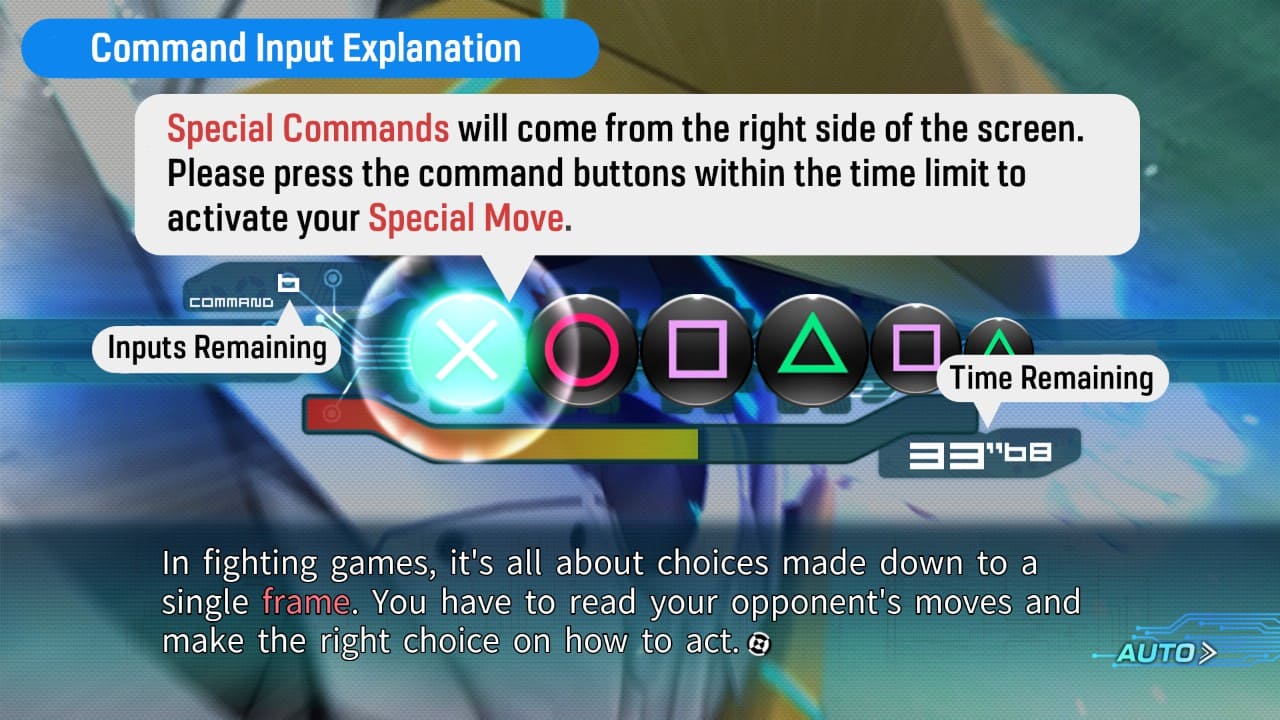
Kill-Ballad’s detailed command inputs and frame data keep the fight tight and technical.
In addition, the game introduces several perspective shifts and interactive elements. For example, the in-game fighting game Kill-Ballad (KB), which Kaito loves to play, offers a playful yet meaningful diversion from the main narrative. These mechanics not only drive the story forward but also deepen your engagement with Robotics;Notes’ evolving world.
The route system works just as it does in other Science Adventure entries—unlocking additional routes requires completing the preceding ones. It’s highly recommended to use the save-locking mechanic to return to key moments, ensuring you can experience every ending.
Adding to this, innovative touches like immersive and interactive technological interfaces—allow players to explore the game’s intricacies at their own pace. Every choice and interaction feels impactful, ensuring that whether you’re immersed in the narrative or engaging with dynamic gameplay features, Robotics;Notes Elite delivers a layered and rewarding experience.

The game’s unique messaging mechanic adds humor, character insight, and branching moments.
A downside of this is, the narrow window for responding to messages, merged with a reliance on trial-and-error to select the right message to progress—can be frustrating. Although the Daily Records feature helps alleviate this headache, it’s still highly advisable to use a guide.
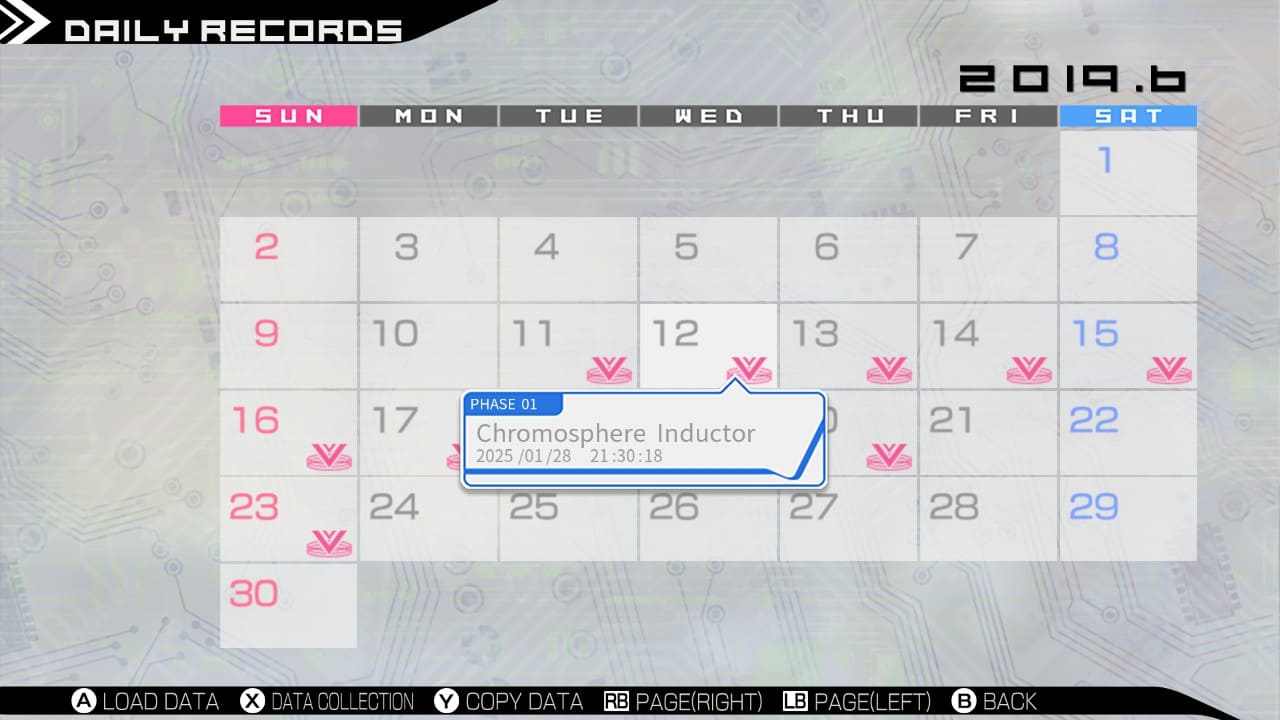
The Daily Records feature lets you rewind to fix mistakes or explore different choices.
Art & Audio
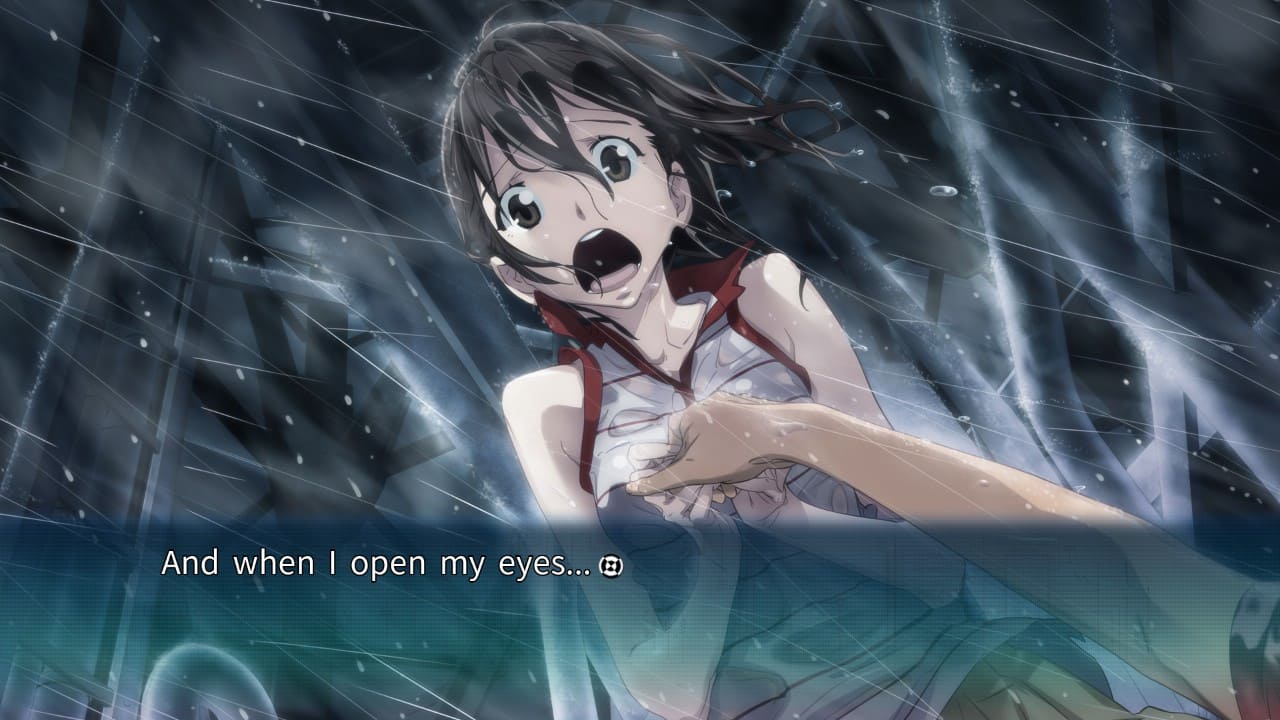
A tense moment as Kaito opens his eyes to Akiho’s panic amidst pouring rain.
Robotics;Notes Elite excels in both its art direction and audio design. The game’s Live2D elements bring the characters to life, lending a more expressive and engaging quality to each scene and enhancing the slice-of-life experience.

A stunning starry sky sets the mood for June 10, 2019.
The art direction creates a calming atmosphere with visually stunning beach areas and starry nights that are a treat for the eyes. Yet, when the narrative shifts to reveal the town’s hidden conspiracies, the visuals take on a more unsettling tone, perfectly mirroring the darker themes at play.
On the audio front, the music is fantastic. The opening track, sung by Zwei, stands out as one of the best in the Science Adventure series, setting a compelling tone right from the start. Composer Takeshi Abo delivers a diverse soundtrack that ranges from upbeat tracks to more ominous pieces that underscore the tension of the current scenes.
Unique Features and Mechanics
Robotics;Notes Elite introduces several innovative mechanics that enhance both its narrative depth and interactivity. Key features include:
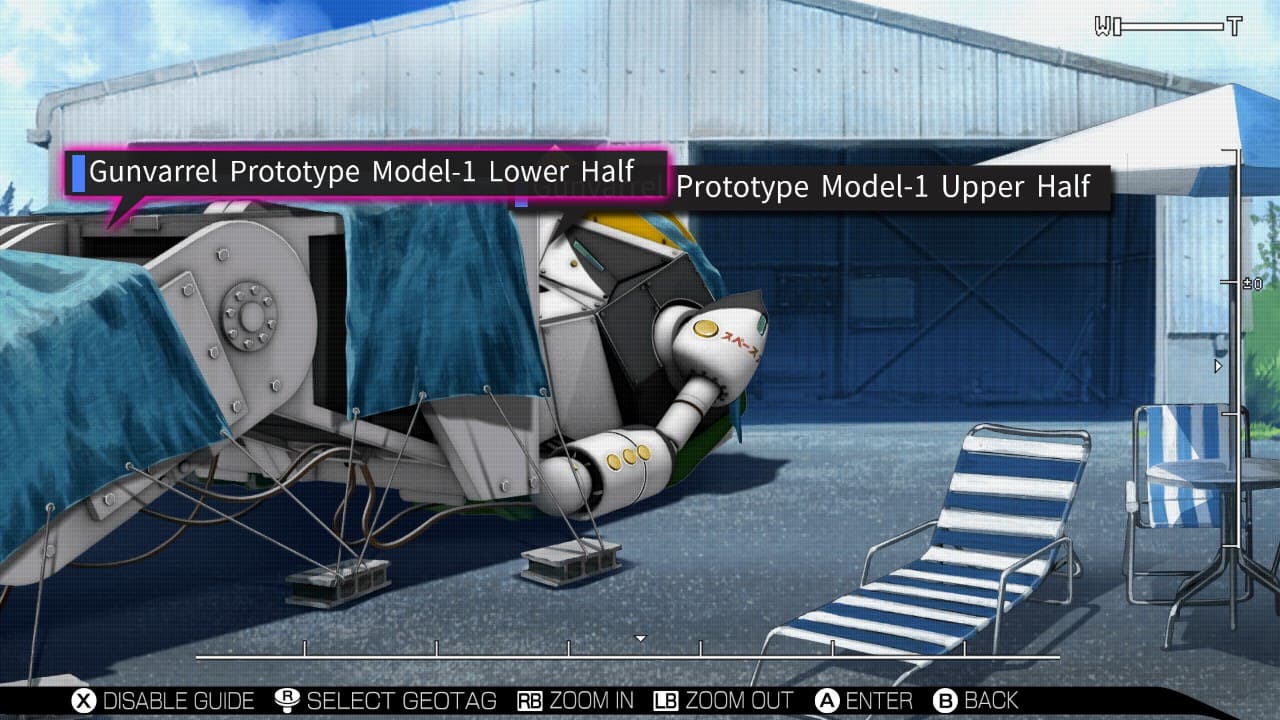
The Gunvarrel Model-1 stands tall in the club’s garage, ready for assembly and action.
- Geotagging via the IRUO Application:
- Found in the PokeCom HUB, geotagging lets you collect detailed information on characters, settings, and objects.
- By switching to a first-person view of your current area, you can inspect every detail—encouraging a careful search for hidden clues and enriching the world-building.
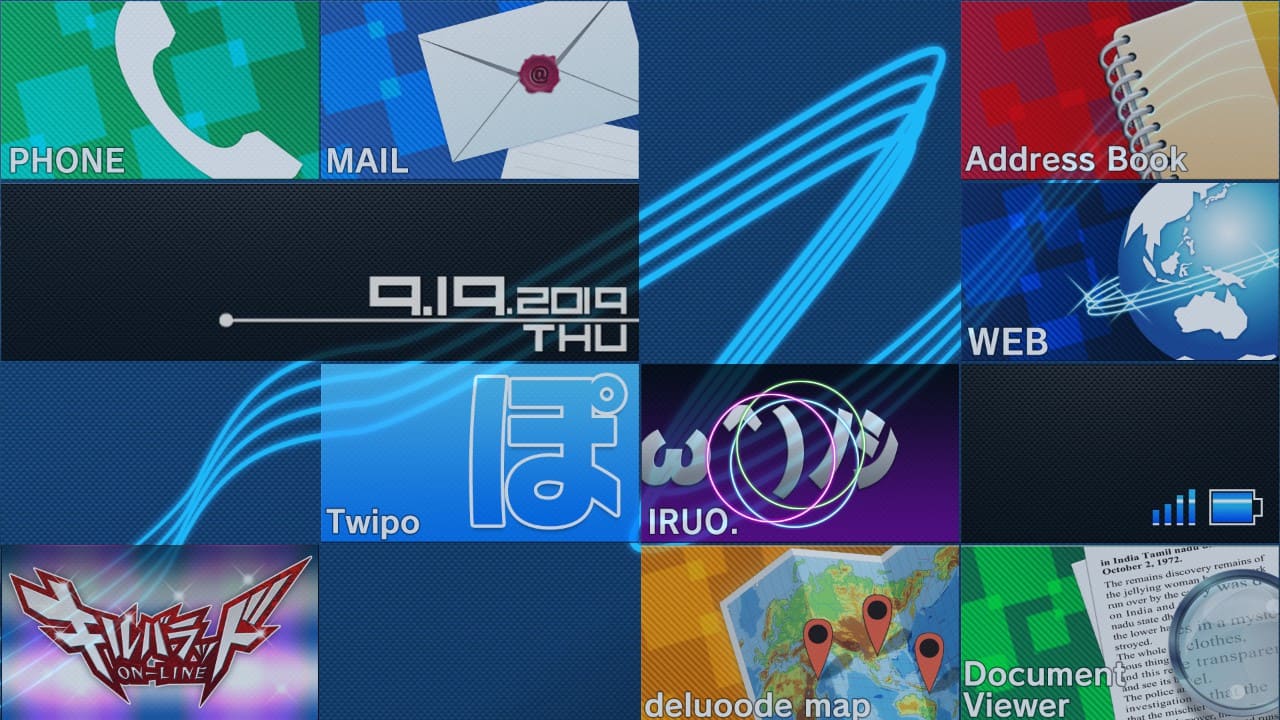
The Pokecom’s versatile apps keep Kaito connected and informed.
- Deluoode Map and Dynamic Perspective Shifts:
- The game integrates perspective shifts with geotags that display time, date, and location information, offering a multifaceted gameplay experience.
- The Deluoode Map, also located in the PokeCom, enables fast travel when appropriate, streamlining exploration and adding strategic depth.
- Daily Records Feature:
- This new mechanic offers an in-game calendar that allows you to jump back to previous moments.
- It’s particularly useful for recovering from mistakes or revisiting key events, ensuring you don’t miss any crucial narrative turns.
Together, these features ensure that Robotics;Notes not only offers a compelling story but also rewards attentive exploration and strategic decision-making.
Seiyuu Performances
Robotics;Notes Elite boasts a very talented voice cast that truly brings its characters to life. Ryohei Kimura perfectly captures Kaito’s apathetic and timid nature, lending him a sense of reluctant charm. Kaori Nazuka delivers an unforgettable performance as Frau, balancing the character’s degenerate traits with an endearing complexity. Yoshino Nanj?, who voices Akiho, the heart of Robotics;Notes, imbues the role with genuine emotional depth. The rest of the cast also shine, each enhancing their characters and adding to the game’s overall immersive experience.
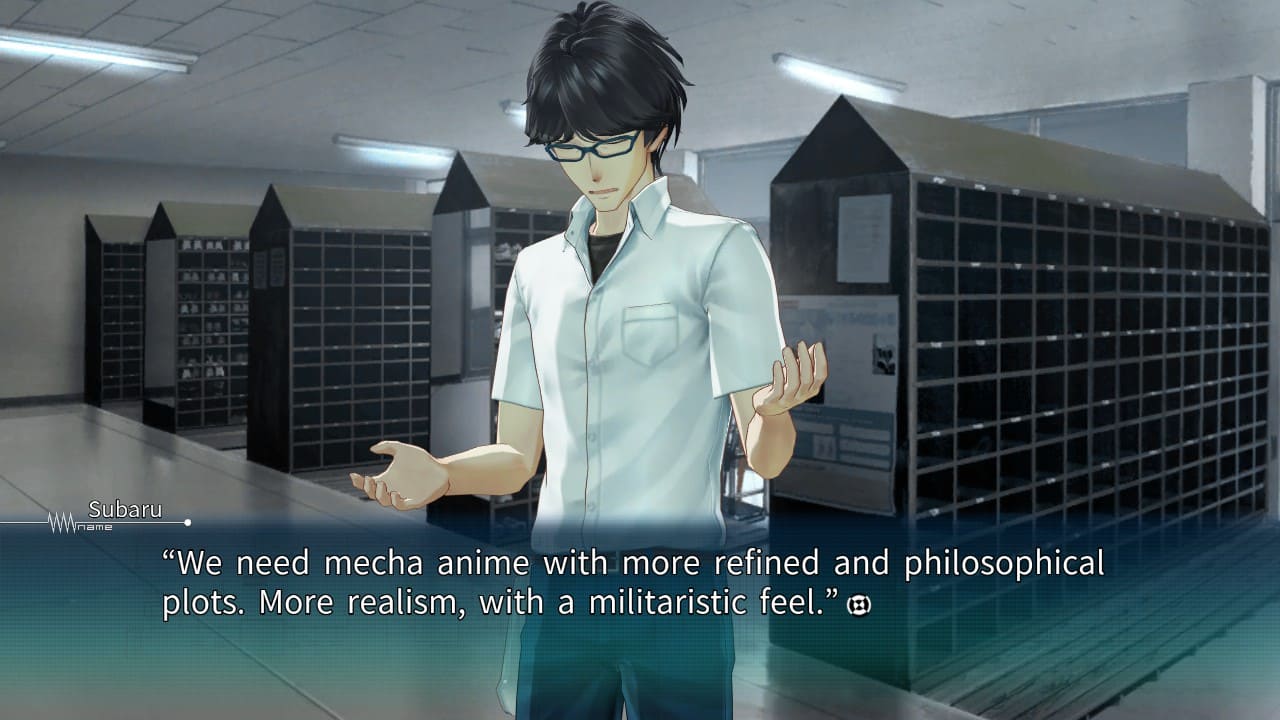
Subaru shrugs off the usual for a call to realism and philosophy in anime.
- Ryohei Kimura
- Known for Hyde from Under Night, Taion from Xenoblade Chronicles 3, Tartaglia from Genshin Impact
- Yoshino Nanjo
- Known for Junah from Metaphor: ReFantazio, Kiria Kurono from Tokyo Mirage Sessions #FE, Eli Ayase from Love Live!
- Rie Kugimiya
- Known for Taiga Aisaka from Toradora, Alphonse Elric from Fullmetal Alchemist, Oda Nobunaga/Cleopatra from Fate
- Kaori Nazuka
- Known for Tsukishiro Yanagi from Zenless Zone Zero, Charlotta from Granblue Fantasy, Miyu Edelfelt from Fate
- Yoshimasa Hosoya
- Known for Basilio from Metaphor: ReFantazio, Robin (Male) from Fire Emblem, Kazuichi Soda from Danganronpa 2
- Sora Tokui
- Known for Momoi Saiba from Blue Archive, Hanabi from Senran Kagura, Tenko Chabashira from Danganronpa V3
Verdict
Completing the Nae route felt like Robotics;Notes Elite was only just getting started—the momentum was beginning to snowball. The game packs in more references and elements from Chaos;Head than Steins;Gate, while still maintaining direct ties to Steins;Gate beyond merely taking place nine years later. In many ways, this entry brings home the greatest strengths of the Science Adventure series when compared to its predecessors.
You’re rewarded handsomely if you experience all the Chaos;Head and Steins;Gate endings, underscoring the importance of playing each visual novel in order. Robotics;Notes Elite exemplifies the series’ evolution with its shift to a more slice-of-life, lighthearted narrative interwoven with moments of suspense that serve as the connective tissue of its universe. Despite sharing the same world, each entry feels fresh thanks to these distinct tonal and thematic differences.
Takeshi Abo’s music is, as always, outstanding—with the opening by Zwei standing out as one of the most addictive tracks in the series. The art direction is fantastic; while the game moves away from traditional 2D visuals, the Live2D implementation is more than serviceable. The character animations, enhanced by a superb seiyuu cast, make even the most eyebrow-raising characters like Frau endearing.
I also loved how intricate the writing was, particularly in its treatment of fighting game terminology. By exploring fundamentals like frame data, whiffing, and other intermediate concepts, the narrative rewards players with a depth of understanding that, as a former fighting game player, I found truly impressive.
A downside, the game takes quite some time for its momentum to build—a pacing that might not suit everyone. Additionally, the ambiguity of the text message choices and the narrow window for responses can be frustrating, making it highly advisable to use a guide.
Overall, Robotics;Notes Elite stands as a layered and rewarding entry in the Science Adventure series, delivering a rich blend of narrative depth, innovative mechanics, and captivating audiovisual presentation—albeit with a few quirks that may need some patience.
TLDR
ROBOTICS;NOTES ELITE (PC)
8.5
Very Strong
Summary: Robotics;Notes Elite expands the Science Adventure universe with a lighter tone, strong character interactions, and deep ties to Chaos;Head and Steins;Gate. The game rewards fans who’ve played prior entries, offering a layered narrative with slice-of-life charm and suspense. Takeshi Abo’s soundtrack and the fantastic seiyuu cast bring the endearing characters to life, while innovative mechanics add depth.
However, the slow build-up may test some players’ patience, and the text message system’s ambiguity makes using a guide, along with the Committee of Zero patch, highly recommended. Despite these quirks, it remains a compelling and rewarding entry in the series.
References
- Announcement Trailer
- Fasty. (2020, October 9). Community Q&A with Spike Chunsoft, Inc. and SciADV producer Tatsuya Matsubara!. Kiri Kiri Basara.
- Lada, J. (2020, July 14). Robotics;Notes Localization Staff Discuss Preparing Elite and DaSH One After Another. Siliconera.
- Zwei – Robotics;Notes Elite OP
- Presage – Takeshi Abo
- Mia. (2020, October 13). Robotics;Notes Elite 100% Guide. Kiri Kiri Basara.


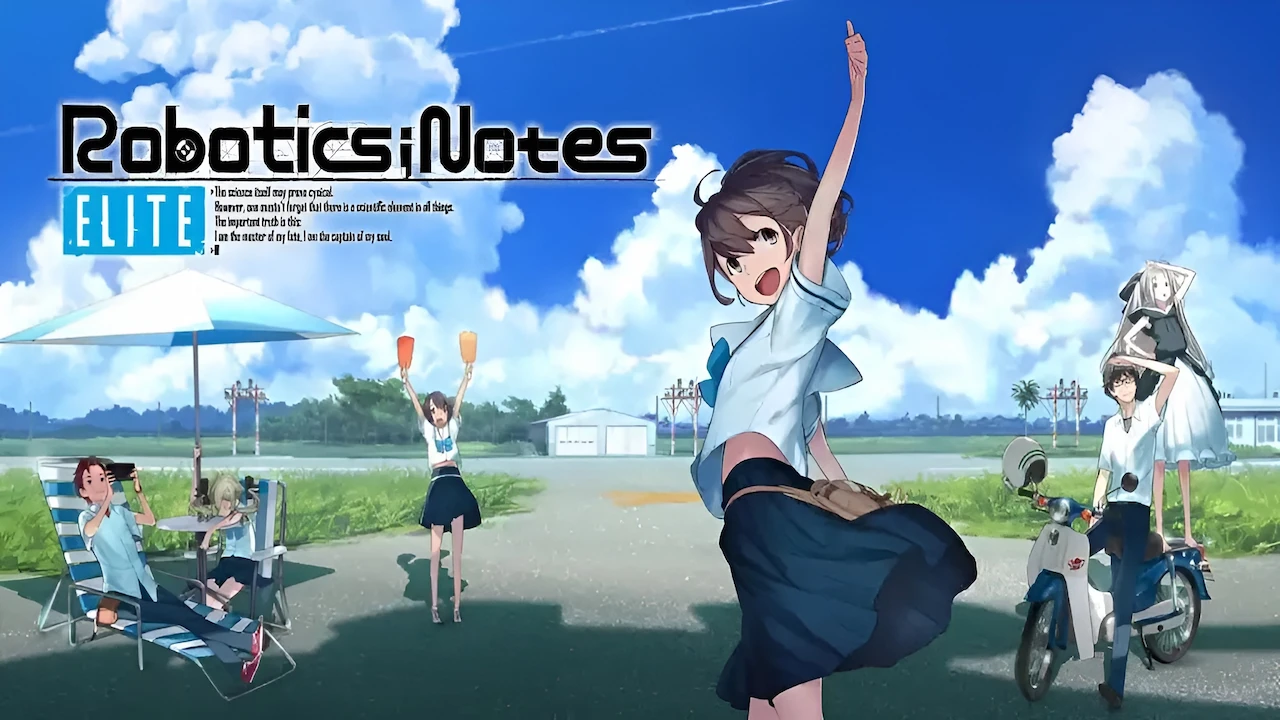
Leave a Reply